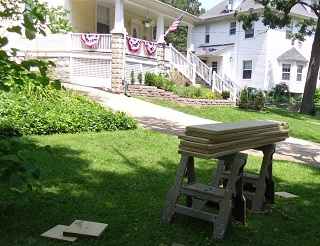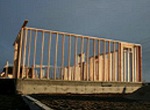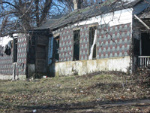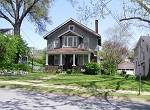Assess Community's Housing Renovation Needs, Then Act
Last Updated: June 20, 2024
Are you wondering how your neighborhood could encourage housing renovation? In government and professional circles, this may be called housing rehabilitation or housing rehab, or sometimes ordinary folks just say remodeling.

Housing renovation begins to become a community issue when homes and neighborhoods are more than about 30 years old, unless incomes are quite ample. This page talks about how neighborhoods and communities can encourage upgrading of homes and not about how individual property owners can plan their own upgrade projects.
The term is more likely to be used in a discussion of urban revitalization, where the homes may be 80 or 100 years old, but it is equally applicable in newer neighborhoods when both architectural style and amenities begin to be "dated," as the real estate industry likes to say now.
Of course, part of that obsessive need for "updating," which is cultivated by real estate agents, media, and a certain demographic segment of home buyers, is just pure hogwash.
At one level there's no reason we all have to have the same stainless steel appliances, quartz countertops, hardwood floors, wallpaper-free homes, and so forth.
On the other hand, in some markets, if your housing stock doesn't conform to those current styles, you're at a competitive disadvantage in comparison to other neighborhoods.
And you do want to compare favorably to other neighborhoods and communities in similar price ranges, if only to maintain property values, tax base, commercial services for your convenience, and a complete community.
Signs Your Neighborhood Needs to Stimulate Housing Renovation
We are interested in helping you identify the need for momentum in housing renovation before neighborhood revitalization becomes a noticeable need.
If everyone in the neighborhood has ample income, motivation, and capability to keep their homes marketable, often you can ignore this page. But right now probably a minority of neighborhoods fall into that category.
Below we describe five early warning signs for needing to drum up some enthusiasm for homeowners to reinvest and for responsible and altruistic investors in your community.
• In general, almost all the housing units are 30 years old or more, and a meaningful number of the original residents are still there but have not made major investments in their homes since they were new.
(In this case, you might be interested in the emerging idea of suburban retrofit as well, where some problems with subdivision design are addressed.)
• Homes in your neighborhood are out of date in terms of features that buyers are seeking. While we think some of those amenities are shallow and represent unnecessary household spending, others are quite important for the way we live today. Garages, large closets, basement or attics, and upgraded electrical service are truly important for most households' comfort.
Ask a couple of real estate agents active in the neighborhood for candid assessments of any patterns they see in people who reject looking at or buying housing in your neighborhood.
Divide short-term style preferences, such as this year we want vessel sinks and no wallpaper, from long-term living trends, such as possession of more cars, stuff, and electrical appliances. If you're out of date in terms of the long-term trends, you'll want to encourage renovation.
• Seeing homes that are actually in disrepair doesn't shock you any more. You see porches falling away, roofs sagging, broken windows, peeling paint, cracked foundations, and so forth, but you no longer notice.
You certainly can survive a few quirky situations of neglect, but once these sights become relatively common, it's time to bone up on the art of restoring communities.
• Your prevailing architectural style has become a caricature for an era, and it's not an era admired by the market. This is especially a problem in large subdivisions and even entire towns that were built at about the same time.
• Cheap construction begins to catch up with you. Anyone who has watched lower-priced homes under construction now, compared to 50 years ago, has to wonder how long these composite wood wonders will last.
Where many of the less expensive shortcuts were employed on a large scale, housing renovation will become an issue much sooner in the life of a home than was the case in the past.
How to Launch a Housing Renovation Program
Community organizations and local governments shouldn't wait for the private market to get serious about housing renovation.
Yes, that may happen in some neighborhoods, where rehabs are trendy, the real estate market is hot, and you have an established community of remodeling or rehab contractors that are always looking for new opportunities to make money.
But if you see one or more of the early warning signs listed above, tune into that factor, painful though it may be. Start recruiting contractors who like remodeling. Many prefer new construction, as it's more straightforward, and therefore predictably profitable.
Major housing renovation requires more stress management, problem solving, resiliency, and inventiveness, and therefore more time. Solutions must be improvised, so there's less profit in repeating the same idea over and over again from one home to another.
Depending on the size and scale of your community or neighborhood, you could cooperate with a real estate agent to actually have a coffee and a tour for the contractors that are neutral to favorable toward remodeling.
Think through the advantages of working in your neighborhood. Try to see it from the contractor's eyes. Are there economies of scale in your housing renovation situation? If you have thousands of homes all built within a 10-year time period, many on a similar house plan, a contractor can actually develop a specialty in upgrading those homes to some of today's essential standards. But you'll have to sell them on this possibility, one by one.
The exception, of course, is for the fortunate few, where your neighborhood is in high demand, probably because of architectural character or great location. Then the contractors will come seeking you, and your primary job is to help residents avoid the bad actors.
But if you're in a position where you could use some neighborhood revitalization, and you are concerned about the lack of reinvestment, start strategizing about building a list of one or more contractors who are really interesting in medium to large-scale housing renovation in your neighborhood.
This is especially true if home owners are unlikely to be quite as aggressive about upgrading and updating their homes as you need them to be, for long-term viability of the neighborhood.
Often this situation occurs when people's incomes are marginal, they are retired and therefore careful about spending, or the folks simply are older, don't care about style, and don't see any need to change what they've been doing for the last 40 years.
The Reinvestment Spiral
Like many community development principles, the prevalence of housing renovation in a neighborhood is a spiral that is moving either upward or downward almost all of the time.
Your community is either on the upswing in terms of reinvestment, because of individual home owner decisions or investor activity, or you are spinning in the wrong direction.
Don't let that downward arc get out of control, because then you have a giant project in front of you. And it's a project that might not succeed, because you've lost your competitive advantage.
So let's think about restoring communities before we're in a crisis. We need to start noticing the warning signs much sooner, and then act.
If Home Owners Are Interested in Housing Renovation and Upgrading
If your residents and/or property owners are motivated, that's a very helpful factor. Then you may be able to have a community-wide event offering information to property owners.
Invite contractors also. You can legitimately point out to good contractors the market you offer, and help people make intelligent matches. Certainly contractors could benefit from being able to work on several houses in the same neighborhood at the same time, or nearly the same time.
Your city government, neighborhood organization, or block unit may find it important and worthwhile to offer information for residents. Communities where housing stock is similar throughout the jurisdiction should hire a community architect who would become a specialist in home renovation in that area. The architect could design typical room addition projects that will make many of our inner ring suburbs viable again.
The building commissioner, or whoever issues building permits, may want to sponsor handouts or web pages to prevent certain common mistakes.
Certainly the government should make the building permit process as painless as possible, perhaps even waiving or lowering fees for major rehabs, especially in neighborhoods that are experiencing disinvestment.
In addition, you'll want to make sure you have adopted an existing building code, rather than simply a code for new construction.
The existing building code contemplates that in the housing rehab situation, an owner might not be able to meet each code provision for new construction. For example, an owner might not be able to have a staircase with today's minimum width and tread depth without basically reconfiguring an entire floor.
If you are only vaguely familiar with the idea of property maintenance codes to force commercial buildings into compliance, our page on the topic will help you understand.
If your neighborhood begins to attract do-it-yourself rehabbers, your neighborhood association or local government might form a club so the renovation community can swap stories, sources for unusual materials common in your area, and perhaps even physical labor.
You'll want to do what you can to attract resellers of architectural details and construction material recyclers to locations convenient to your neighborhood. If you're in a small town or city, start up such a venture, even if on a non-profit basis.
Another very worthwhile and relatively low-effort project to support your do-it-yourself crowd is to assemble and manage a tool library. Yes, you could check out a specialized tool for a week, just as you would check out a book from a library. Think of the expense saved if you could "borrow" a tile cutter, a floor sander, and so forth. In larger cities it is certainly possible to rent these, and the giant home centers also will rent some equipment, but if the expense and hassle can be minimized through local community organization action, that will be more convenient.
In low-income and what the federal government defines as moderate-income neighborhoods, housing rehabilitation is a very common use of Community Development Block Grant (CDBG) funds. Cities of more than 50,000 population are entitled to these funds; smaller jurisdictions have to apply, usually on a competitive basis, within a state.
Public hearings and other community engagement channels are required by federal law, so you can organize your neighborhood to ask for more CDBG funding to be set aside for housing renovation, and specifically for programs that target your neighborhood.
If you have low-income homeowners, learning the inside scoop on this program is one of the highest-impact housing rehab activities you can undertake. The programs may be structured as grants or loans. However, do be aware that funding limitations on the amount of CDBG funds that can be spent on each home may make this funding source inadequate to undertake the degree of renovation that you or your neighborhood need.
In sum, I hate to tell you this, but it's not just your home that needs attention this weekend; it could be the neighborhood too.
Related to Rehabilitation Programs for Cities, Neighborhoods, or CDCs
- Making and Keeping a Good Community >
- Housing Issues > Housing Renovation
Join GOOD COMMUNITY PLUS, which provides you monthly with short features or tips about timely topics for neighborhoods, towns and cities, community organizations, and rural or small town environments. Unsubscribe any time. Give it a try.



